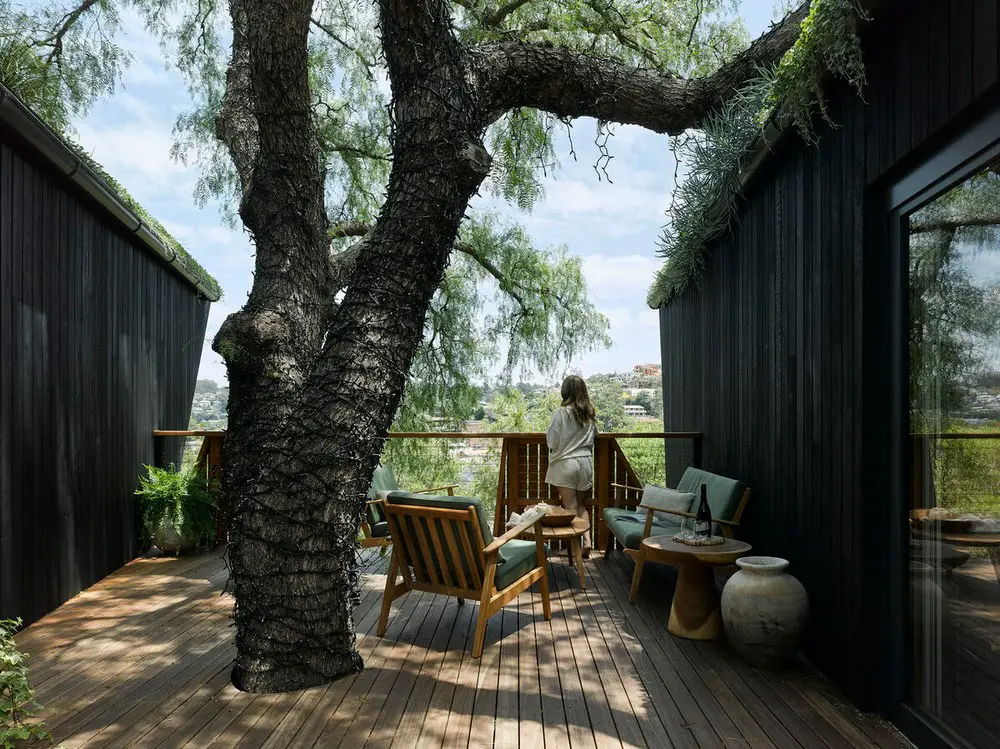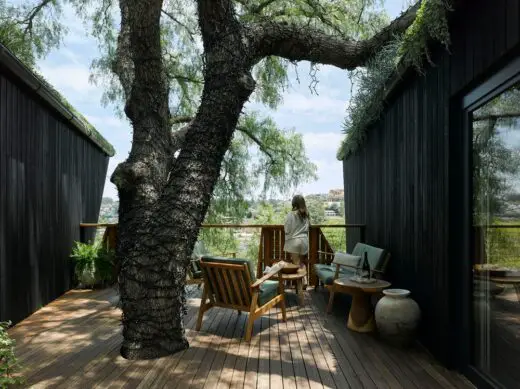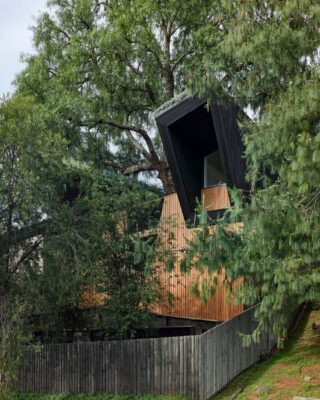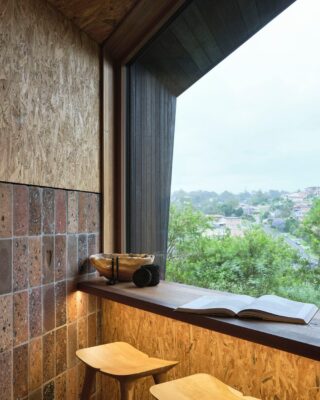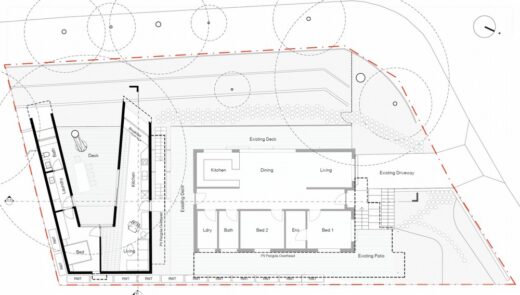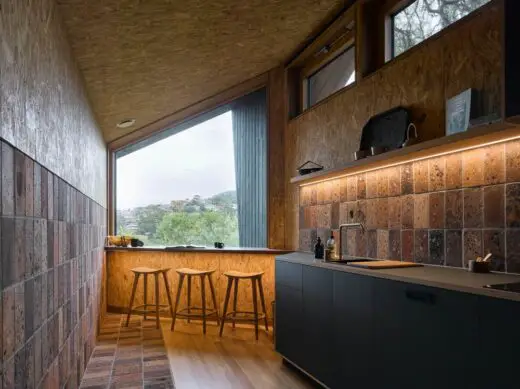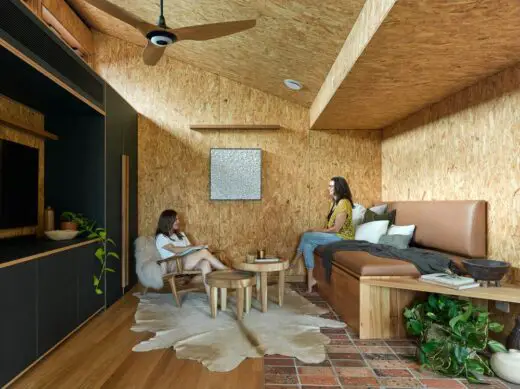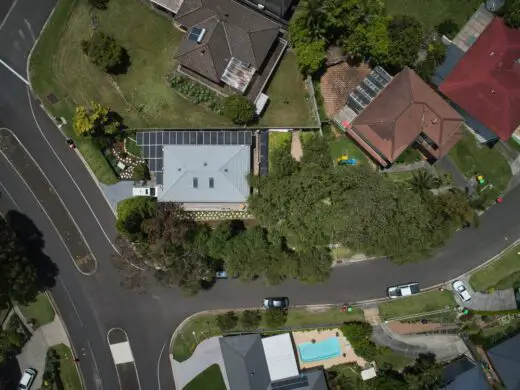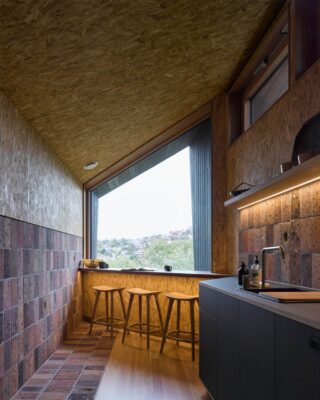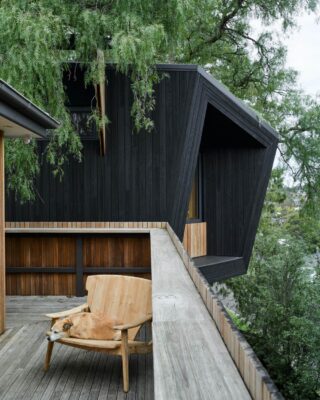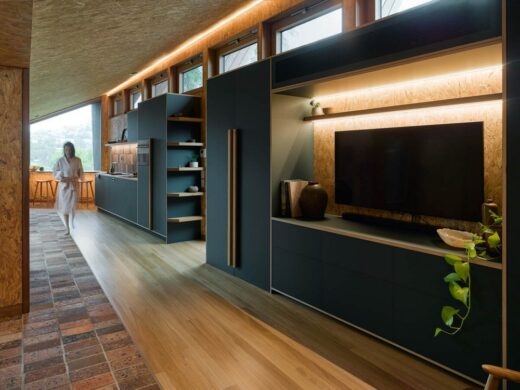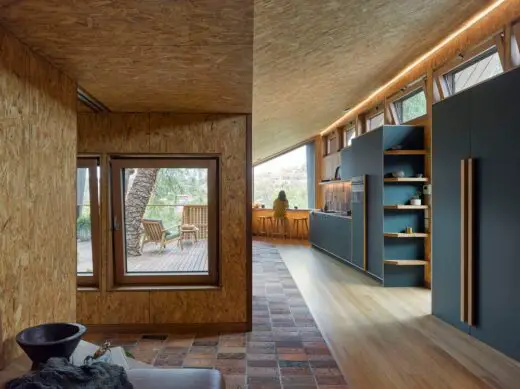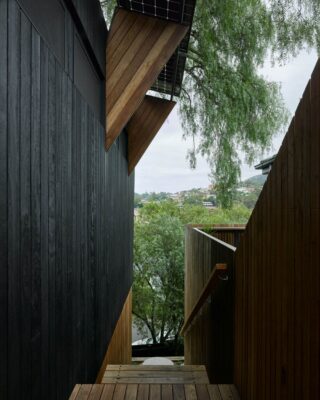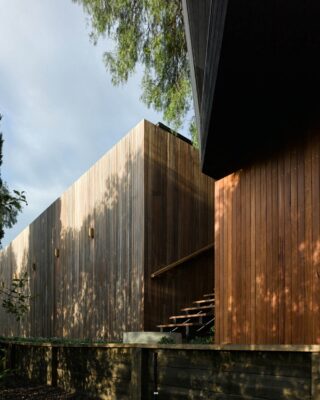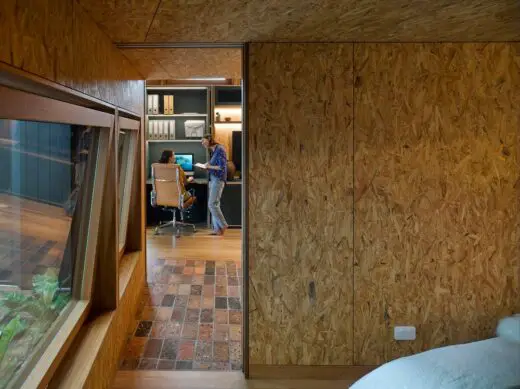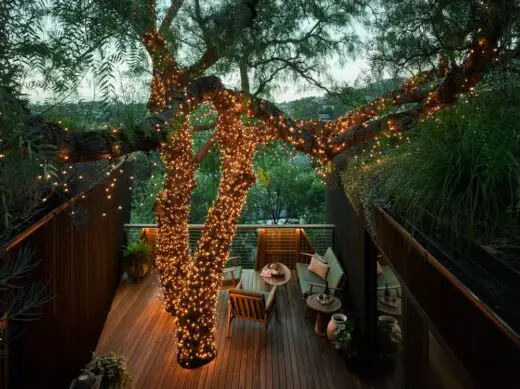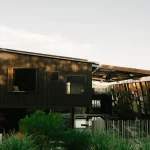Pepper Tree Passive House, New South Wales, Sydney Real Estate, NSW Home, Green Australia Building Design Images
Pepper Tree Passive House in New South Wales
8 Aug 2022
Design: Alexander Symes Architect
Location: Illawarra region, New South Wales, Australia
Photos: Barton Taylor
Pepper Tree Passive House, NSW
Pepper Tree Passive House is a small secondary dwelling to a young family’s home in the Australian Illawarra region, perched on a steep site and elevated into the canopy of the site’s eponymous 60 year old Pepper Tree. Built to the international Passive House standard, true sustainability is at the core ethos of the project – embodied between the natural material palette, high performance design and strong biophilic connection. The two cantilevered wings each host a green roof, filled with native Australian plants, blending the building into the landscape.
The secondary dwelling provides a much needed separate office space for the clients’ growing company, as well as providing space for guest accommodation and being geared for short-stay accommodation. The works to the existing home improve the thermal comfort of the space and create new entertaining spaces throughout. Between the natural and raw material palette including extensive timber use, endemic rooftop gardens and tree canopy deck, the biophilic connection of the entire site is strengthened with its immediate environment.
Nestled into the tree canopy of the Pepper Tree, the secondary dwelling sits lightly on the steep site and elevates the natural ground via its green roofs, with the recycled Shou Sugi Ban cladding allowing the building to blend into its environment. Previously exposed to the street corner below, the wrap-around deck to the existing home creates spaces for entertaining that provide both a noise and visual buffer to the street, and direct views over the street tree canopies towards Mount Kembla. The project adds much needed usable floor space to the suburban site without overdeveloping or sacrificing biophilic connection.
By using salvaged and waste materials throughout, costs were significantly reduced without sacrificing material quality. Passive House standard and 12kW photovoltaic panel system means that the project’s overall grid energy consumption is only 14% of a comparable sized home (86% reduction), significantly reducing the lifetime cost to the clients. As opposed to thermally upgrading 160m2 to the passive house standard, only 60m2 will actually be comfortable in future peak climatic conditions. This approach provides a precedent for creating small future-proofed additions so that we can be climate adaptive without the massive cost of upgrading all existing dwellings.
What was the initial brief and how did it develop?
While the existing home had a tired and thermally inefficient brick exterior, internally the home’s layout functioned perfectly for the young family. As a response, the project brief developed into one where the existing home had its external envelope upgraded – including new insulation where practical, a ventilated timber screen facade, new skylights, a wrap around deck and solar panel pergola – and a striking secondary dwelling was designed around the 60 year old Pepper Tree in the steeply sloping and under-utilised rear yard.
The secondary dwelling was envisioned as a 24-hour space; used as a home office by the family’s growing business during the day, and a short-term stay cabin at night. Designed and built to meet the Passive House standard, the short term stays allow visitors to experience the higher quality of space that the Passive House standard affords, while creating a future proofed studio with western views to Mount Kembla and the treetops outside. Each wing of the secondary dwelling hosts an endemic-planted green roof, allowing the biodiversity of the site to be regenerated despite the extended building footprint created.
Where did collaboration lead to success in this project?
The project was first envisioned several years ago by both the client (who is a builder with a Passive House specialty – Souter Built), and Alexander Symes Architect. After the initial concept and design was developed, the client/builder began to salvage and store materials from other projects that would have otherwise gone to waste, for use on this project. This early coordination between architect and client/builder flows throughout the project; from recycled timber and pavers made from waste-concrete, down to screws and fixings left over from other jobs, doing so allowed a massive reduction in virgin materials used.
Sustainability Attributes of the Project:
Built to the Passive House standard, the project meets the 5 core criteria:
– Well insulated (R5.4 Walls, R5.0 Floors, R6.5 Ceiling/Roof)
– Airtight construction (2 layers – external vapour-permeable membrane and internal sealed Intello membrane, 0.51ACH @ 50Pa)
– High Performance Glazing (Neuffer triple-glazed, timber/aluminium composite framed windows)
– No Thermal Bridges (carefully detailed and constructed timber structure with no thermal bridges between internal and external)
– Heat Recovery Ventilation (Brink Reinvent Excellent 180 Heat Recovery Ventilation unit)
A Life-Cycle Assessment was conducted that showed despite the higher amount of embodied energy associated with Passive House construction, due to the small, high performance building envelope, low-embodied carbon material selection and significant on-site generated & exported renewable energy, the building’s environmental footprint is 64% less than a comparable built-as-usual home in the same climate zone.
Other sustainability attributes:
– Fully electric building (no gas)
– Grid energy used is 100% accredited GreenPower
– Heat pump hot water
– Induction cooktop
– 12kW PV system, 14kWh battery
– Triple glazed, alu-clad timber windows
– 4000L rainwater tank, serving Laundry and Bathroom
– Construction waste material fully diverted
– No internal paint, 0-VOC and E0 finishes and materials used where possible
– Endemic and edible landscape.
Pepper Tree Passive House in New South Wales, Australia – Building Information
Architects: Alexander Symes Architect – https://alexandersymes.com.au/
Project size: 60 sqm
Site size: 617 sqm
Completion date: 2021
Building levels: 1
Client / Builder: Souter Built
Photography: Barton Taylor
Pepper Tree Passive House, New South Wales images / information received 080822
Location: Illawarra region, New South Wales, Australia
New Architecture in Sydney
Contemporary Sydney Buildings
Sydney Architectural Designs – chronological list
Sydney Architecture Walking Tours by e-architect – tailored NSW city walks
Sydney Modern Project
Architects: Kazuyo Sejima + Ryue Nishizawa / SANAA
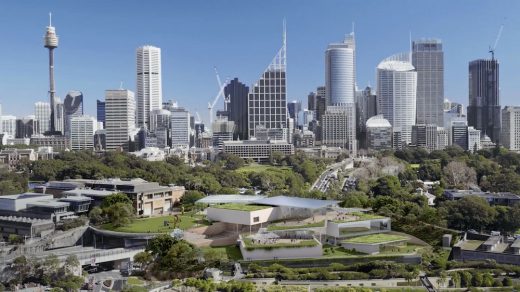
image © AGNSW
Sydney Modern Project Art Museum Building
Brookfield Place Sydney
Design: Make Architects
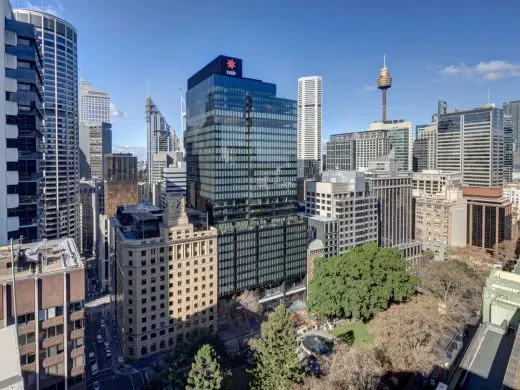
photo : Brett Boardman
Brookfield Place
NSW Architecture
Macquarie University’s new central courtyard, Balaclava Road, Macquarie Park, NSW 2109
Architects: ASPECT Studios and Architectus
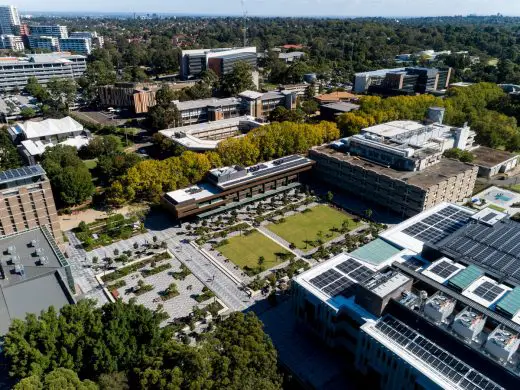
photo : Brett Boardman
Macquarie University new central courtyard
African Savannah, Taronga Zoo, Bradleys Head Rd, Mosman, NSW 2088
Architects: Tonkin Zulaikha Greer
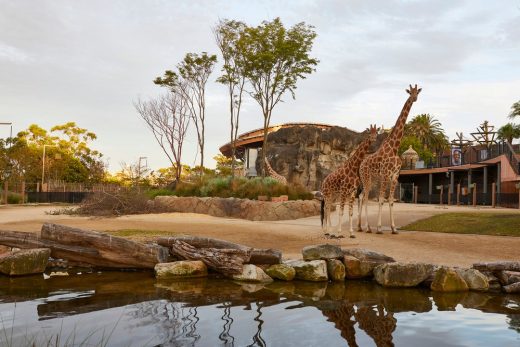
photos by Martin Mischkulnig and Tim Shaw
Taronga Zoo African Savannah
Comments / photos for the Pepper Tree Passive House, New South Wales designed by Alexander Symes Architect page welcome

